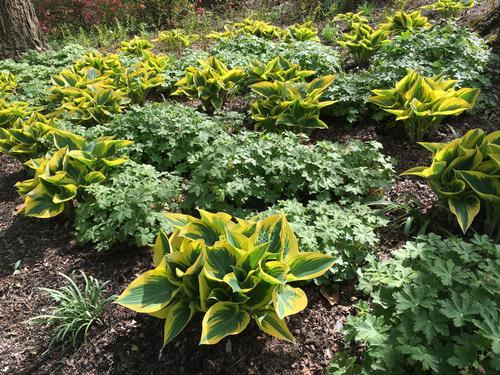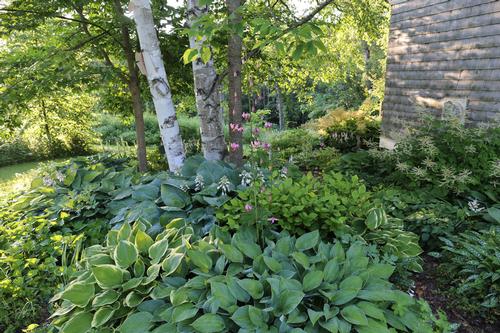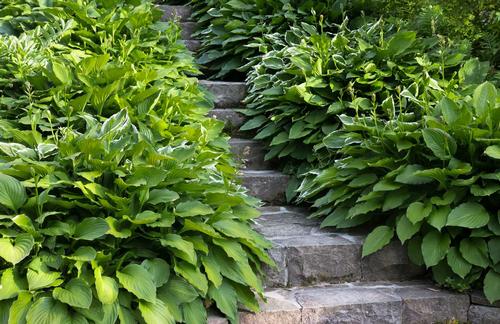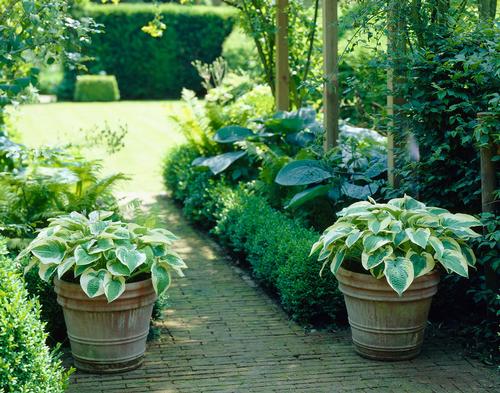Discover New Ways to Enjoy the Beauty of Hostas
Hostas are so incredibly tough and easy to grow that they sometime don’t get the respect they deserve. More than just problem solvers for shady areas where few other plants will survive, hostas offer gardeners an exciting palette of sizes, colors and textures.
Read on to learn about some creative ways to use hostas around your home and in your garden.
Plant Hostas with Hostas
With so many different types of hostas to choose from, it's easy to create a beautiful shade garden that contains nothing but hostas. If you do this, you'll want cultivars that are different enough to be interesting, yet similar enough to look like they belong together. Strive for a tapestry of foliage with repeating shapes and colors.
As a general rule, large plantings of hostas should include mostly solid greens and blues. Create visual interest with variations in leaf sizes and textures. You’ll also want to incorporate some plants with variegated foliage, making sure to echo the same green and blue hues.

Hostas with yellow foliage (both solid and variegated) add bright, unexpected color in the landscape. They’re best used as accent plants or grouped into drifts that snake their way through other plantings.

Pair Hostas with Spring Bulbs
Hostas are excellent companions for spring-blooming bulbs. They are relatively slow to emerge and start unfurling their leaves just as daffodils, scilla, crocus, fritillaria and other bulbs begin to fade away. Old-fashioned bleeding heart (Dicentra spectablis) is another good companion for hostas. Once these spring bloomers have finished flowering, the foliage dies back to the ground, leaving a gap behind. Hostas waste no time in quickly filling the space.

Pair Hostas with Shade-Tolerant Flowers
Hostas are attractive companions for other perennials such as astilbes, ferns, dicentra and heuchera. You can also pair them with shade-tolerant annuals such as impatiens, nicotiana, coleus, caladium and begonias.
When using hostas with flowering plants, look for opportunities to create color echoes. Consider pairing pale yellow Nicotiana langsdorfii with hosta Golden Tiara's pale yellow leaf margins. Combine a white astilbe, aruncus or columbine with a green and white hosta like Patriot. Or positioning a burgundy-leaved heuchera near a richly-colored hellebore and a lime-green hosta like Sum and Substance.

Use Hostas as Ground Covers
Hostas are a good solution for shaded areas where there’s not enough sun to grow a healthy lawn. They are also far more interesting! It’s best to plant small-leaved, low-growing hostas separately from big-leaved cultivars. When planted side by side, small hostas read as holes in the tapestry of foliage. Instead, plant them where you can admire them up close, such as at the edge of a path or beside some steps. They also look great in a partially shaded rock garden.

Plant Hostas in Containers
If you plant decorative containers for a shady porch or patio, consider incorporating hostas. Feature them alone in a pot or add them to a mixed container. Choose small or mid-size varieties so they don’t overwhelm their neighbors. Hosta foliage complements colorful annuals and will stay fresh all season.
You can purchase a potted hosta in spring or simply use a sharp spade to slice out a small section from a plant already in your garden. In northern areas, you'll need to remove the plant from the pot in the fall and put it in the ground for the winter.
To learn more, read All About Hostas, 10 Easy Perennials for Shady Gardens, Best Ground Covers for Shade and Design Tips for Shady Gardens.


